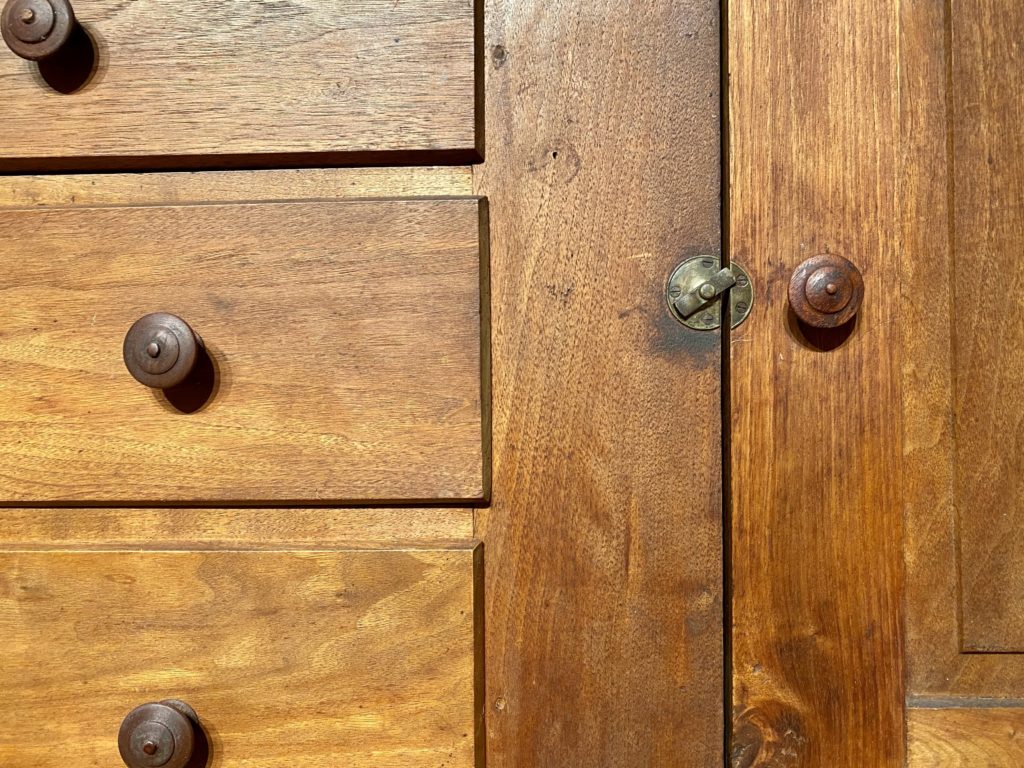M. Stephen Miller
(c) Connecticut Explored Inc., Winter 2022-23
Subscribe/Buy the Issue!
Connecticut’s built environment has a great number and variety of works to delight the eye and the mind. Many of these are readily visible, while some are a bit harder to find. One notable example of the latter is a monumental built-in case piece of furniture that was rescued from a derelict building, the laundry-wash house raised in 1858, located in the former Shaker community in the town of Enfield. Designed to store linens, blankets, and towels, the piece is made up of 22 drawers surrounded by six cupboards.
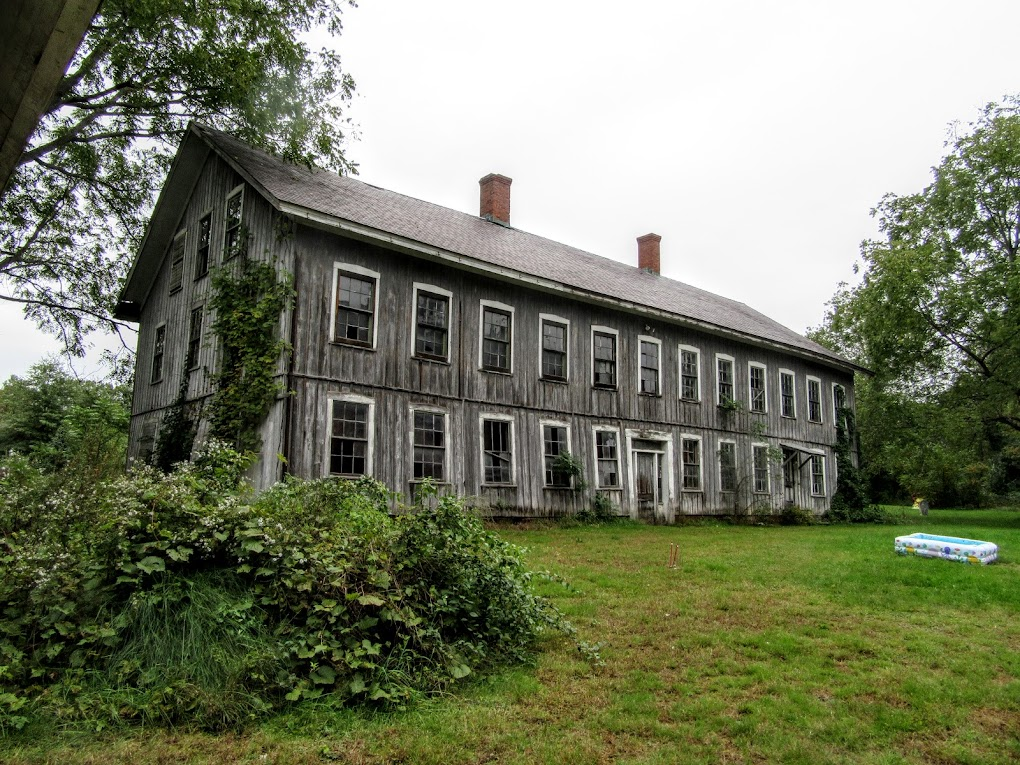 In 1774 a small band of Shakers immigrated to the American colonies from England. Almost immediately they established a village, apart from “the World,” just north of Albany, New York, in a town then known as Niskeyuna (today, Watervliet). Soon, guided by their spiritual leader, “Mother” Ann Lee, they set about proselytizing throughout New England. Ultimately, a preacher named Joseph Meacham, who was born in Enfield, Connecticut, converted to the Shaker faith and brought his large Baptist congregation with him. He and his family dedicated their contiguous farms in Enfield to the faith.
In 1774 a small band of Shakers immigrated to the American colonies from England. Almost immediately they established a village, apart from “the World,” just north of Albany, New York, in a town then known as Niskeyuna (today, Watervliet). Soon, guided by their spiritual leader, “Mother” Ann Lee, they set about proselytizing throughout New England. Ultimately, a preacher named Joseph Meacham, who was born in Enfield, Connecticut, converted to the Shaker faith and brought his large Baptist congregation with him. He and his family dedicated their contiguous farms in Enfield to the faith.
A permanent village was “gathered into order,” or fully organized, in Enfield (and a portion of neighboring Somers) in 1792. This community, occupying some 3,000 acres, reached its maximum population of 256 residents in 1830. The community was dissolved after 125 years in 1917 because its membership had dwindled to an unsustainable number, according to Stephen J. Paterwic in The Shakers of Enfield, Connecticut: 1780-1968 (Richard W. Couper Press, 2020). Most of their lands today house the main state prison system for Connecticut.
The larger Enfield community was divided into five smaller, semi-independent, non-biological “families” or socio-political units: North, South, East, West, and, in the center, the Church Family. The community in Enfield existed until 1913, when the few remaining Shakers of the South Family sold their large tract of land to Peter and Stanislau Cybulski. It remains in the same family today. The dwelling house, where the South Family members lived and ate, still stands. (Cybulski v. Planning and Zoning Commission, 1994 Ct. Sup. 1728) About 200 feet away, the building where all the families’ laundry was washed, dried, and stored still stands—though barely!
In 2014 when I was curator of the Shaker Collection at the New Britain Museum of American Art (NBMAA), I worked with a team of assistants to carefully remove this storage piece over a span of two days. We had it thoroughly cleaned and the wood “fed” with restorative oils, then permanently installed at the museum—precisely recreating its original setting.
Fortunately, no alterations to the piece’s structure or surfaces had been undertaken in 156 years, other than some missing pulls (which were precisely reproduced, matching both their black walnut wood and the angle of their threads), the piece was totally intact. Today, it stands as the centerpiece of the Shaker Gallery at the NBMAA.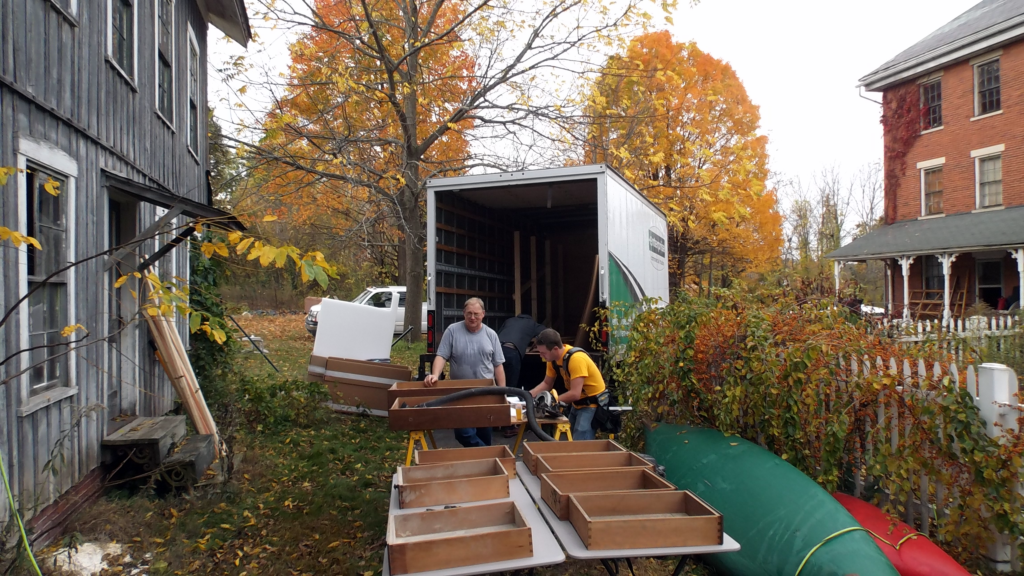
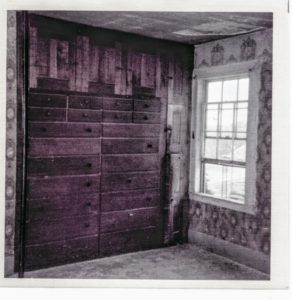 The drawer fronts, doors, and frame are made from butternut, or white walnut, wood. (Groves of these trees still stand on nearby land.) The drawer sides, runners, and cupboard shelves are white pine, and the drawer bottoms are poplar. The distinctive features of the drawers are their tapered sides, with wider bases and narrower tops. Also, the top edges have a half-round profile. This combination of construction detail is extremely rare in 19th-century cabinetry and identifies the maker as Shaker Brother Grove Wright (1789-1861).
The drawer fronts, doors, and frame are made from butternut, or white walnut, wood. (Groves of these trees still stand on nearby land.) The drawer sides, runners, and cupboard shelves are white pine, and the drawer bottoms are poplar. The distinctive features of the drawers are their tapered sides, with wider bases and narrower tops. Also, the top edges have a half-round profile. This combination of construction detail is extremely rare in 19th-century cabinetry and identifies the maker as Shaker Brother Grove Wright (1789-1861).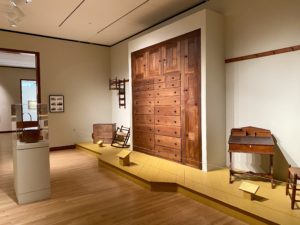
The NBMAA is one of only three art museums in the United States with a permanent Shaker display, the others being the Philadelphia Museum of Art and the Metropolitan Museum of Art. Visit NBMAA.org for museum hours and other information.
M. Stephen Miller is the current curator of the Shaker Collection at the New Britain Museum of American Art. His new exhibition, “Handled with Care: The Function of Form in Shaker Craft” opened there in early February of this year. It will be followed this summer with “Masterworks of Shaker Design” in July. His most recent books are From Shaker Lands and Shaker Hands: A Survey of the Industries (2007) and Inspired Innovations: A Celebration of Shaker Ingenuity (2010), both published by University Press of New England.
For more information about the Enfield Shakers see “Enfield’s Shaker Legacy,” Connecticut Explored, Summer 2005 at https://www.ctexplored.org/enfields-shaker-legacy/. 

